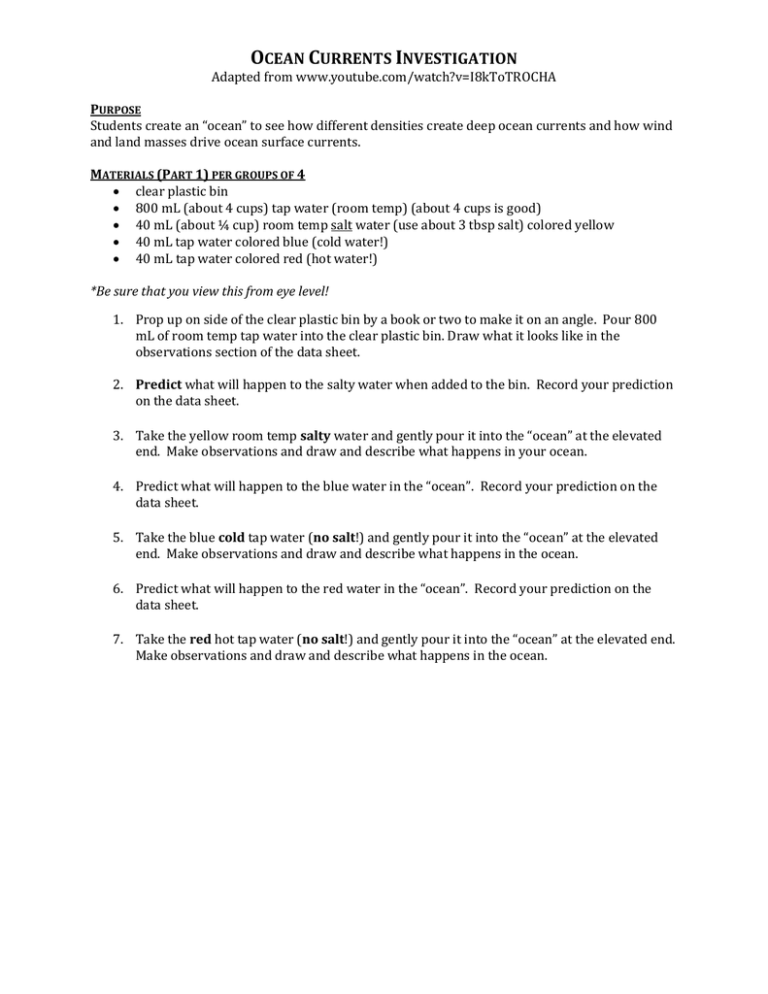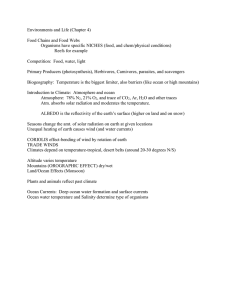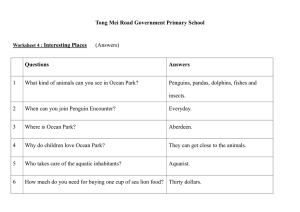OCEAN CURRENTS INVESTIGATION
advertisement

OCEAN CURRENTS INVESTIGATION Adapted from www.youtube.com/watch?v=I8kToTROCHA PURPOSE Students create an “ocean” to see how different densities create deep ocean currents and how wind and land masses drive ocean surface currents. MATERIALS (PART 1) PER GROUPS OF 4 • clear plastic bin • 800 mL (about 4 cups) tap water (room temp) (about 4 cups is good) • 40 mL (about ¼ cup) room temp salt water (use about 3 tbsp salt) colored yellow • 40 mL tap water colored blue (cold water!) • 40 mL tap water colored red (hot water!) *Be sure that you view this from eye level! 1. Prop up on side of the clear plastic bin by a book or two to make it on an angle. Pour 800 mL of room temp tap water into the clear plastic bin. Draw what it looks like in the observations section of the data sheet. 2. Predict what will happen to the salty water when added to the bin. Record your prediction on the data sheet. 3. Take the yellow room temp salty water and gently pour it into the “ocean” at the elevated end. Make observations and draw and describe what happens in your ocean. 4. Predict what will happen to the blue water in the “ocean”. Record your prediction on the data sheet. 5. Take the blue cold tap water (no salt!) and gently pour it into the “ocean” at the elevated end. Make observations and draw and describe what happens in the ocean. 6. Predict what will happen to the red water in the “ocean”. Record your prediction on the data sheet. 7. Take the red hot tap water (no salt!) and gently pour it into the “ocean” at the elevated end. Make observations and draw and describe what happens in the ocean. GLOBAL WINDS PURPOSE Students will identify and understand the forces that cause ocean surface currents around the world. TEACHER BACKGROUND INFORMATION Ocean surface currents are an integral part of the Earth system. Knowledge of the surface currents provide us with a better understanding of global climate and weather patterns, as well as living conditions, migration patterns, and life cycle journeys of plants and animals, including humans. Studying ocean currents can also be useful in ship navigation, which has a direct impact on the economy, in search and rescue operations, and in tracking oil spills. MATERIALS (PART 2) • pepper • straws with flexible neck (one per student—only those who create wind) • waterproof objects (like rocks to act as landmasses) PROCEDURE 1. Distribute pepper, rocks, straws, Ocean Currents Data Sheet, and a copy of the Global Winds sheet to each group of students. Remove the book that raised one end of the plastic bin so that the bin is now flat on a table/desk. Do not dump out the water. 2. Have them sprinkle pepper across the top of the water. From opposite corners of the pan, they should use the straws to gently blow across the water’s surface. The lower section of the straw should be close to the water. (Determine which straw position will best simulate a current of moving pepper first and demonstrate.) 3. Have students sketch the path of the pepper during the blowing of the “wind” on the observation section of data sheet in green. 4. Instruct groups to place a rock or similar object in the water so that is only partially submerged. 5. Before blowing through the straws, ask students to make predictions about what effect this “landmass” will have on the current of pepper. Have them share their predictions. 6. Tell students to blow through the straws from the same direction as before, and observe the current of moving pepper. 7. Have students sketch the path of the pepper as it encounters the landmass. Do this in red, or a different color than the first wind example. 8. Instruct groups to add another partially submerged object (“landmass”) and repeat the above procedure. (Predict, blow, and sketch). 9. Using a copy of the Global Winds sheet, ask students to predict the direction of flow for major ocean currents in the Pacific Ocean. 10. Provide a copy (show on overhead or from internet) of the Major Ocean Surface Currents sheet (same as Duck Duck Data World Map) and have students compare their expectations with the actual ocean surface currents. OCEAN CURRENTS DATA SHEET Predictions 1. What do you think will happen when you add the yellow salty water? 2. What do you think will happen when you add the blue cold tap water? 3. What do you think will happen when you add the red hot tap water? Observations Plastic Bin Book What happens in the ocean when the sun warms the top layer of the water? What does this tell you about deep ocean currents? How does water move from the surface of the ocean to deeper areas? WIND PATTERNS This rectangle is the bin and you are looking down on it from above. 1. Place an X where you placed the straws’ ends to create wind. 2. Draw, with green arrows, the direction that the pepper moved across the ocean. 3. Draw the location of your landmasses as if this rectangle is the bin and you are looking down on it from above. 4. Draw, with red arrows, the directions that the pepper moved when the landforms were in the ocean. 1. What force did blowing through the straw imitate? 2. What causes wind? 3. What did the objects placed in the water represent? 4. Why was pepper needed in this simulation? 5. Did the pepper move in a path that you expected? 6. When you compared the global wind patterns with the ocean surface currents, was it a perfect match? 7. What factors other than winds do you think influence ocean surface currents? 8. Did the simulated surface current affect the particles on the bottom? Global Winds = warm air = cold air = Tradewinds = Westerlies = Polar Easterlies




